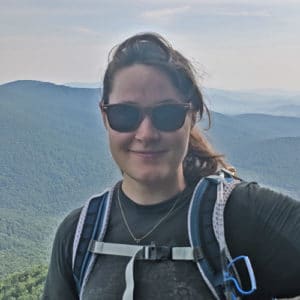

Stephanie Bernasconi is a valuable asset to Stroud Water Research Center’s Ecosystem Ecology Group. She is one of the staff scientists that collected and processed samples for the milldam removal study featured in last month’s UpStream Newsletter.
“In the field, I collect sediment cores and water samples from rivers that have dams on them. I bring those back to the lab to run different analyses on them, like denitrification enzyme assays, which measures how active the denitrifying bacteria are. I also run all the water samples on our discrete analyzer for a variety of different nutrients, like phosphate, ammonium, nitrate, and chloride. Eventually, Dr. Marc Peipoch, my principal investigator, will use the data I have generated to publish papers.”
From Salt Water to Fresh
Bernasconi joined the team in 2018, having earned her master’s degree at Louisiana State University studying the effects of suspended solids on oysters. “[Oysters] are filter feeders and high total suspended solids can affect some of their biological processes,” she said. Bernasconi also spent time studying the effects of ocean acidification on oysters at the Smithsonian Environmental Research Center after earning her bachelor’s degree in Environmental Science at Dickinson College. She originally wanted to be a marine biologist, but after a semester abroad on a tall sailing ship she decided to stick to studying fresh water. “I realized 15 minutes into our six-week trip that I get incredibly seasick!”
Bernasconi considers this a blessing, though. “Unlike a lot of our staff at the Stroud Center, I grew up in the area. The Stroud Center has always been a pillar in our community. I remember coming here as a Brownie Girl Scout for a tour of the lab. Somehow I chose all the right paths to get the experience I needed to work here. They must have been sending subliminal messages on those tours.”
Along with her work on the milldam project, Bernasconi is involved in the William Penn Farm Practices Project as well as monitoring of White Clay Creek watershed and the Brandywine River. “[The William Penn Farm Practices Project] spans most of the departments at the Stroud Center. We are studying the effects of different farm practices on surface water and groundwater.” Bernasconi analyzes all of the water samples and farm soil sediment extractions in addition to helping out with the rainfall simulator. She also works on storm sampling, the recent USDA project, and a project monitoring fish populations in Maryland for the National Park Service.
Bridging Science and Education
Bernasconi also works as a part-time educator at the Stroud Center, and she loves participating in both research and educational initiatives. “Teaching is super important,” Bernasconi said. “I was an environmental education coordinator at the Brandywine Red Clay Alliance before this position, and I worked with the Girl Scouts of Eastern Pennsylvania to bring science camps to underserved children in Chester County before that. It’s been more research heavy since the pandemic hit, but I still help out the education department with things now and then.”
When asked about future projects, Bernasconi expects to participate in initiatives involving the environment as a whole. “Before I joined the Stroud Center staff, I had zero experience working with soils and gases. Now, I do that all the time. Who would have thought that a freshwater research center would go in that direction, but our scientists are realizing that the interaction between the air and the ground is increasingly important to study.”



